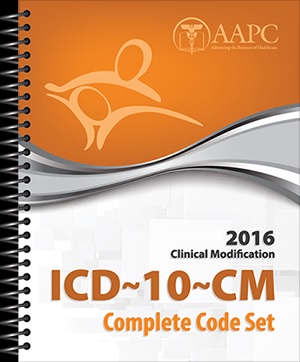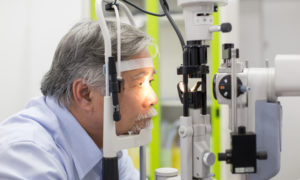By Chad Fleming, OD, FAAO
Sept. 28, 2016

SYNOPSIS
ICD-10 has been in effect one year. Assess your adoption success, and improve on timely and reliable reimbursement for your services.
ACTION POINTS
ASSESS ADOPTION SUCCESS. How promptly were you reimbursed immediately after implementation of ICD-10, and how quickly are you reimbursed now?
ENSURE CONTINUED PROGRESS. Meet at least quarterly with other doctors and staff in the practice to walk through coding and billing cases.
CONSIDER OUTSIDE HELP. For as little as $300 a month, an outside service can speed reimbursement and lower claims rejected and returned.
ICD-10 allows for more precise coding for better tracking and care of patients. For that reason, the implementation of this new system of coding a year ago represented a step forward in patient care.
I can now find all of my patients with moderate glaucoma and those with mild glaucoma. I can also drill into which patients currently have diabetic macular edema with type 2 diabetes and mild non-proliferative retinopathy. ICD-10 also created a system for payers to reimburse based on how difficult the patient diagnosis is to manage.
It may be hard to believe, but after all the dread and preparations, a year has elapsed since the implementation of ICD-10. My practice, like many of yours, carefully prepared. The preparations mostly paid off, but there has been a glitch here and there that we had to learn from. We have learned from those glitches and made improvements to keep our coding and billing process as efficient as possible.
Getting coding right is essential as reimbursement is the lifeblood of practice net cash flow. Approximately 60 percent of revenues that come into my practice are reimbursable.
Our running accounts receivable (AR) for both private and insurance is 75 percent of what our monthly net collections is. So, if month-ending net collections is $100,000, then our (current-90 days) AR total, private and insurance, is approximately $75,000. Our percentages break down as follows on average: 80% of total AR is current-30 days; 7% is 30-60 days; 5% is 60-90 days; and 8% is 90+ days (95% is private pay of the 90+).
Our monthly write-off rate is less than 2 percent of our running AR total.
Assess What’s Better Now Compared to ICD-9
ICD-10 is much more efficient because coders can differentiate what happened in the patient encounter. The codes are more specific, which helps discern which eye and the outcome of the encounter. We know not to do “unspecified eye” because insurance does not allow “unspecified” codes to go through when submitting claims.

Dr. Fleming says educational resources like ICD-10-CM Complete Code Set from Advancing the Business of Healthcare (AAPC) enabled him to train his staff effectively in ICD-10, which went into effect a year ago. Dr. Fleming says it’s worth spot-checking coding periodically to ensure your level of reimbursement is not being adversely affected by inaccurate coding.
Assess Adoption Success
In the first few months after the implementation of ICD-10, we experienced a delay in payments of four weeks. The delay was remedied by figuring out what Medicare needed. Medicare had our routine programmed incorrectly, so if you put a refraction code on any part of the claim then Medicare would deny it. In other words, Medicare was not separating the refraction ICD from the medical. We caught this problem immediately, and Medicare updated its system to not deny.
Other than that initial delay in payment, there were no big surprises, and the transition to this new system of coding went smoothly. A big reason for that was the training we did with our support staff and doctors on the requirements of the new coding system.
We had our staff go through trial runs of ICD-10 in which they coded hypothetical files to make sure they got the hang of it ahead of time.
Every one of my staff and doctors would agree that our EHR system was the key to making the transition smooth. We leaned heavily on our EHR, which has auto-coding, which helps you select the right ICD-10 code. It also alerts us when a code has been entered wrong.
The resource that provided the greatest help to us was the ICD-10-CM Complete Code Set from Advancing the Business of Healthcare (AAPC). We used this book to quiz ourselves in our practice sessions, and we still use it as a reference when we are stumped, and our EHR also isn’t able to tell us exactly what the best code would be.
No Change for Patient Experience
Patients seemed to not even know a transition occurred at our office. The new system does not change the time frame during which the patient finds out about insurance coverage, and whether they are left with anything additional to pay us.
Due to optometry having a limited number of diagnoses, the transition was much easier than some colleagues in the health field, like urology or orthopedics, which we know is still struggling with the transition due to the massive amount of codes that are now entirely different.
Ensure It Continues to Go Right
We meet as doctors to walk through cases and discuss how we are coding and billing those cases. I also run reports about every other month to look at the coding habits of each of the doctors and compare and contrast so that we are all similar in the way we code. If I identify outliers like one doctor coding a high percentage of 99214, or not coding any gonioscopy procedures, then we will discuss as a doctor team what common acceptable billing and coding practices are. Iron sharpens iron, as they say, and as doctors we only get better when we work to sharpen each other.
Get Outside Help, If Needed to Safeguard Practice
We have hired a company that randomly audits our exams/coding and gives us a report based on doctor and coding habits.
Our PM software does not subjectively look at what the reason for a patient visit was, and then compare that to the coded ICD-10. Our PM software also does not look at the individual insurances to see if they correspond with how we interpreted the reason for the visit, and which was vision or medical.
Also, our PM software does not follow through the logical story of what a patient was in for, does it deserve a 99xxx or 92xxx code, were tests done appropriately, was the I&R documented appropriately due to CMS guidelines, etc. Our PM software does a great job objectively, but an audit will be subjective interpretation. The ability to have individuals who do audits, or defend audits, comb through each of our doctor’s charts (as a “friendly audit”), and give feedback, is why we believe this third-party help to be so important. PM software can only look at filled-in fields and checked boxes.
We proactively spend $300 month on this third-party service to prepare ourselves for an audit. We believe that with the continued changes in coding and reimbursement structure, audits will be very easy to run and cost-effective for insurance companies. Therefore, they will naturally increase. We want to verify that we are continuing to evolve with the face of healthcare, and getting our charts audited by an independent third party helps us do that.
Chad Fleming, OD, FAAO, is a partner with Wichita Optometry, P. A. in Wichita, Kan. To contact: optometryceo@gmail.com



























